Comprehensive Financial Analysis of Huawei: A Detailed Report
VerifiedAdded on 2021/06/18
|18
|3040
|494
Report
AI Summary
This report provides a detailed financial analysis of Huawei, examining its financial position, performance, and growth. The analysis includes horizontal and vertical analysis, financial ratio analysis (liquidity, profitability, activity, and leverage), and DuPont analysis to assess the company's financial health. The report also investigates Huawei's microeconomic performance, considering factors such as customers, workers, competitors, suppliers, and shareholders. The study compares Huawei's financial data from 2015 and 2016, including balance sheets and cash flow statements, to evaluate its financial stability and profitability. The report also discusses the company's financial growth, including revenue, net and operating profit, equity, and cash inflow trends. The conclusion summarizes Huawei's financial strengths and its potential for future growth in the global telecommunications market.

Financial Analysis of Huawei 1
FINANCIAL ANALYSIS OF HUAWEI
By Name
Course
Instructor
Institution
Location
Date
FINANCIAL ANALYSIS OF HUAWEI
By Name
Course
Instructor
Institution
Location
Date
Paraphrase This Document
Need a fresh take? Get an instant paraphrase of this document with our AI Paraphraser
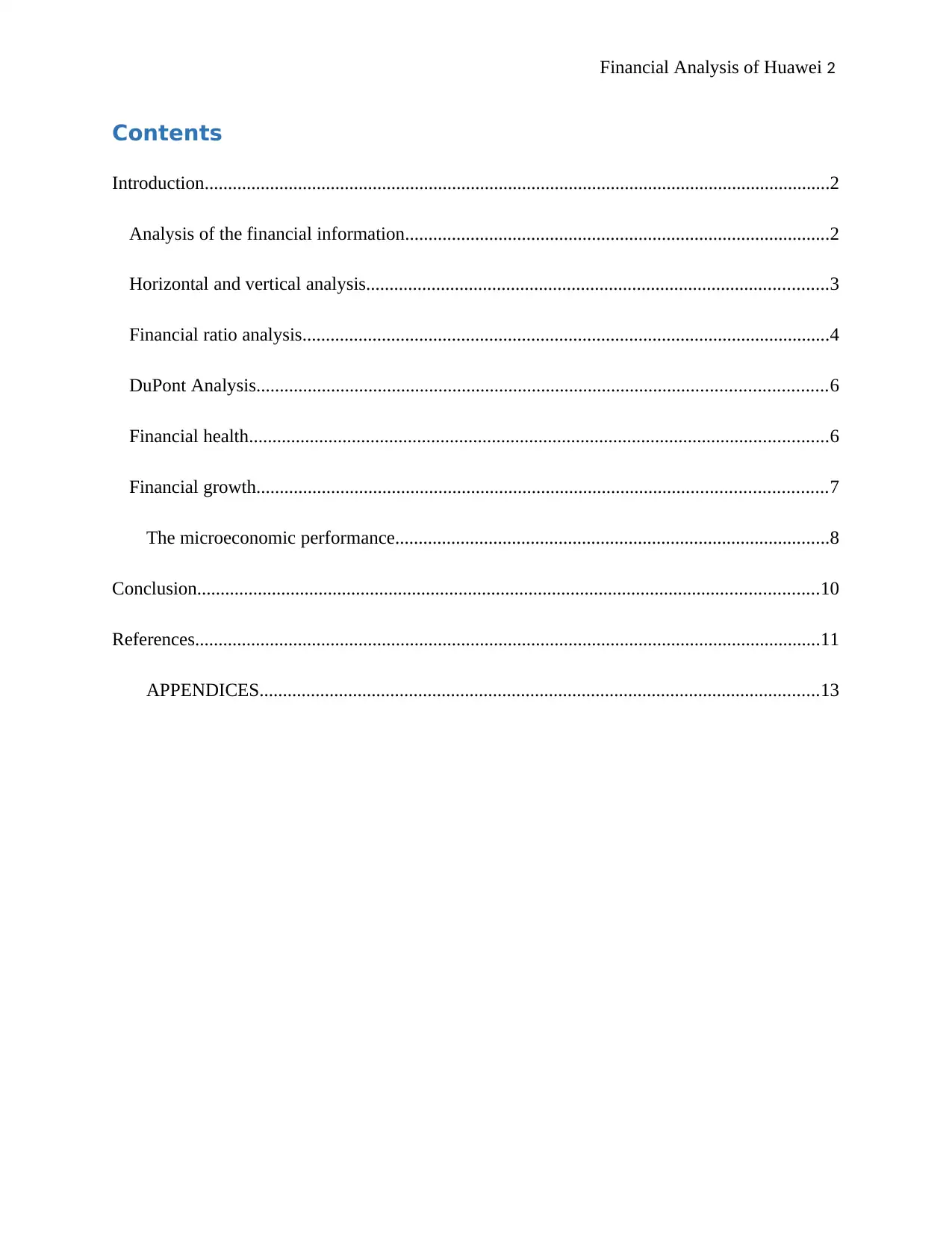
Financial Analysis of Huawei 2
Contents
Introduction......................................................................................................................................2
Analysis of the financial information...........................................................................................2
Horizontal and vertical analysis...................................................................................................3
Financial ratio analysis.................................................................................................................4
DuPont Analysis..........................................................................................................................6
Financial health............................................................................................................................6
Financial growth..........................................................................................................................7
The microeconomic performance.............................................................................................8
Conclusion.....................................................................................................................................10
References......................................................................................................................................11
APPENDICES........................................................................................................................13
Contents
Introduction......................................................................................................................................2
Analysis of the financial information...........................................................................................2
Horizontal and vertical analysis...................................................................................................3
Financial ratio analysis.................................................................................................................4
DuPont Analysis..........................................................................................................................6
Financial health............................................................................................................................6
Financial growth..........................................................................................................................7
The microeconomic performance.............................................................................................8
Conclusion.....................................................................................................................................10
References......................................................................................................................................11
APPENDICES........................................................................................................................13
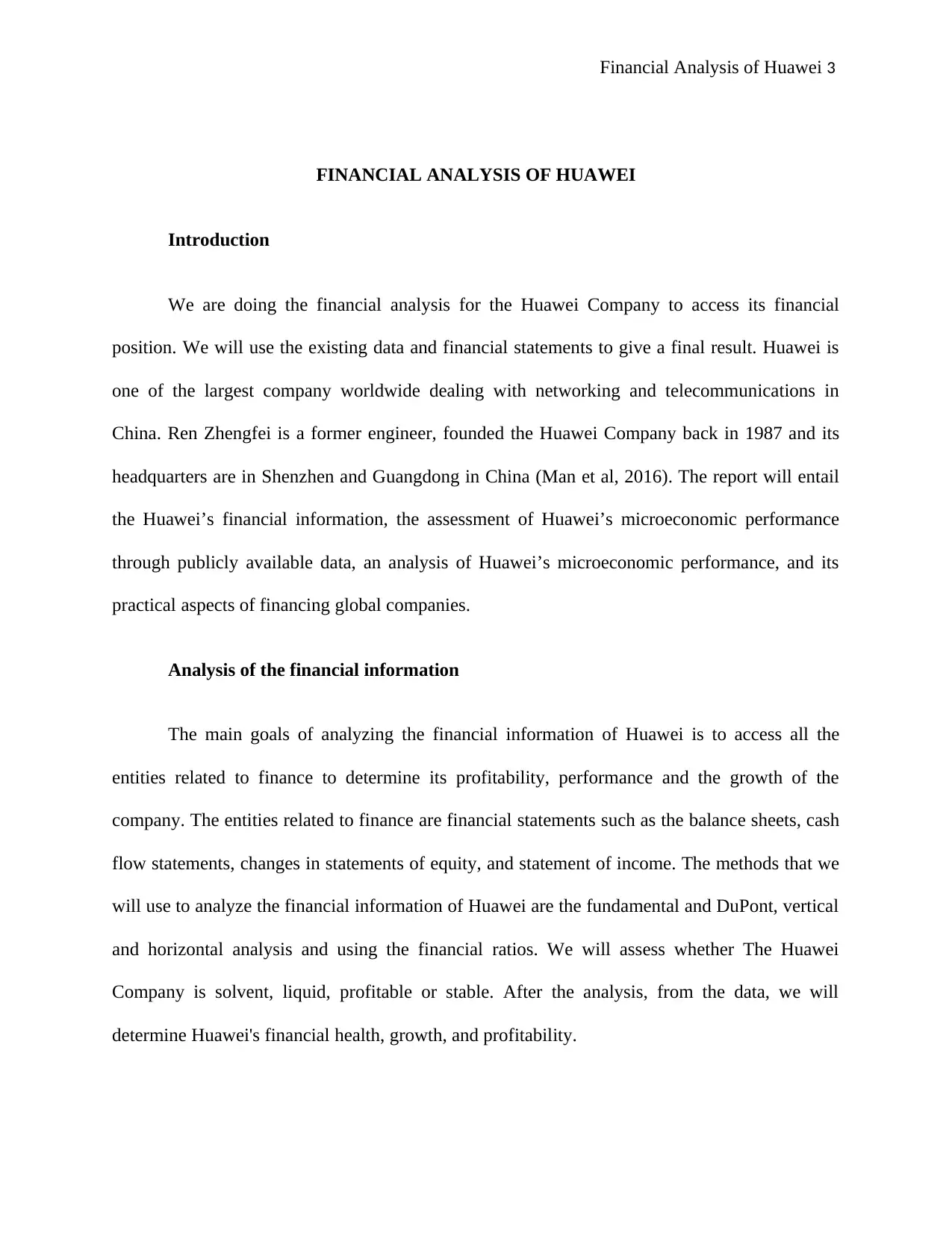
Financial Analysis of Huawei 3
FINANCIAL ANALYSIS OF HUAWEI
Introduction
We are doing the financial analysis for the Huawei Company to access its financial
position. We will use the existing data and financial statements to give a final result. Huawei is
one of the largest company worldwide dealing with networking and telecommunications in
China. Ren Zhengfei is a former engineer, founded the Huawei Company back in 1987 and its
headquarters are in Shenzhen and Guangdong in China (Man et al, 2016). The report will entail
the Huawei’s financial information, the assessment of Huawei’s microeconomic performance
through publicly available data, an analysis of Huawei’s microeconomic performance, and its
practical aspects of financing global companies.
Analysis of the financial information
The main goals of analyzing the financial information of Huawei is to access all the
entities related to finance to determine its profitability, performance and the growth of the
company. The entities related to finance are financial statements such as the balance sheets, cash
flow statements, changes in statements of equity, and statement of income. The methods that we
will use to analyze the financial information of Huawei are the fundamental and DuPont, vertical
and horizontal analysis and using the financial ratios. We will assess whether The Huawei
Company is solvent, liquid, profitable or stable. After the analysis, from the data, we will
determine Huawei's financial health, growth, and profitability.
FINANCIAL ANALYSIS OF HUAWEI
Introduction
We are doing the financial analysis for the Huawei Company to access its financial
position. We will use the existing data and financial statements to give a final result. Huawei is
one of the largest company worldwide dealing with networking and telecommunications in
China. Ren Zhengfei is a former engineer, founded the Huawei Company back in 1987 and its
headquarters are in Shenzhen and Guangdong in China (Man et al, 2016). The report will entail
the Huawei’s financial information, the assessment of Huawei’s microeconomic performance
through publicly available data, an analysis of Huawei’s microeconomic performance, and its
practical aspects of financing global companies.
Analysis of the financial information
The main goals of analyzing the financial information of Huawei is to access all the
entities related to finance to determine its profitability, performance and the growth of the
company. The entities related to finance are financial statements such as the balance sheets, cash
flow statements, changes in statements of equity, and statement of income. The methods that we
will use to analyze the financial information of Huawei are the fundamental and DuPont, vertical
and horizontal analysis and using the financial ratios. We will assess whether The Huawei
Company is solvent, liquid, profitable or stable. After the analysis, from the data, we will
determine Huawei's financial health, growth, and profitability.
⊘ This is a preview!⊘
Do you want full access?
Subscribe today to unlock all pages.

Trusted by 1+ million students worldwide

Financial Analysis of Huawei 4
Horizontal and vertical analysis: The horizontal analysis gives a comparison of the
financial situation of a company over a given period of time. The vertical analysis, on the other
hand, gives the percentage of one commodity in comparison to another. We did a comparison
between 2015 and 1016 balance sheets and statements of cash flows.
Huawei’s balance sheet as at 31st December 2016
Fixed assets 88132 Equity attributable 14094
Current assets 355502 No interest 39
Total assets 443634 Total equity value 140,133
Long term liabilities 64,230
Current liabilities 239,279
Total liabilities 303501
443634443634
Huawei’s balance sheet as at 31stDecember 2015
Fixed assets 70509 Equity attributable 119021
Current assets 301646 No interest 48
Total assets 372155 Total equity value 119069
Long term liabilities 40459
Current liabilities 212627
Horizontal and vertical analysis: The horizontal analysis gives a comparison of the
financial situation of a company over a given period of time. The vertical analysis, on the other
hand, gives the percentage of one commodity in comparison to another. We did a comparison
between 2015 and 1016 balance sheets and statements of cash flows.
Huawei’s balance sheet as at 31st December 2016
Fixed assets 88132 Equity attributable 14094
Current assets 355502 No interest 39
Total assets 443634 Total equity value 140,133
Long term liabilities 64,230
Current liabilities 239,279
Total liabilities 303501
443634443634
Huawei’s balance sheet as at 31stDecember 2015
Fixed assets 70509 Equity attributable 119021
Current assets 301646 No interest 48
Total assets 372155 Total equity value 119069
Long term liabilities 40459
Current liabilities 212627
Paraphrase This Document
Need a fresh take? Get an instant paraphrase of this document with our AI Paraphraser
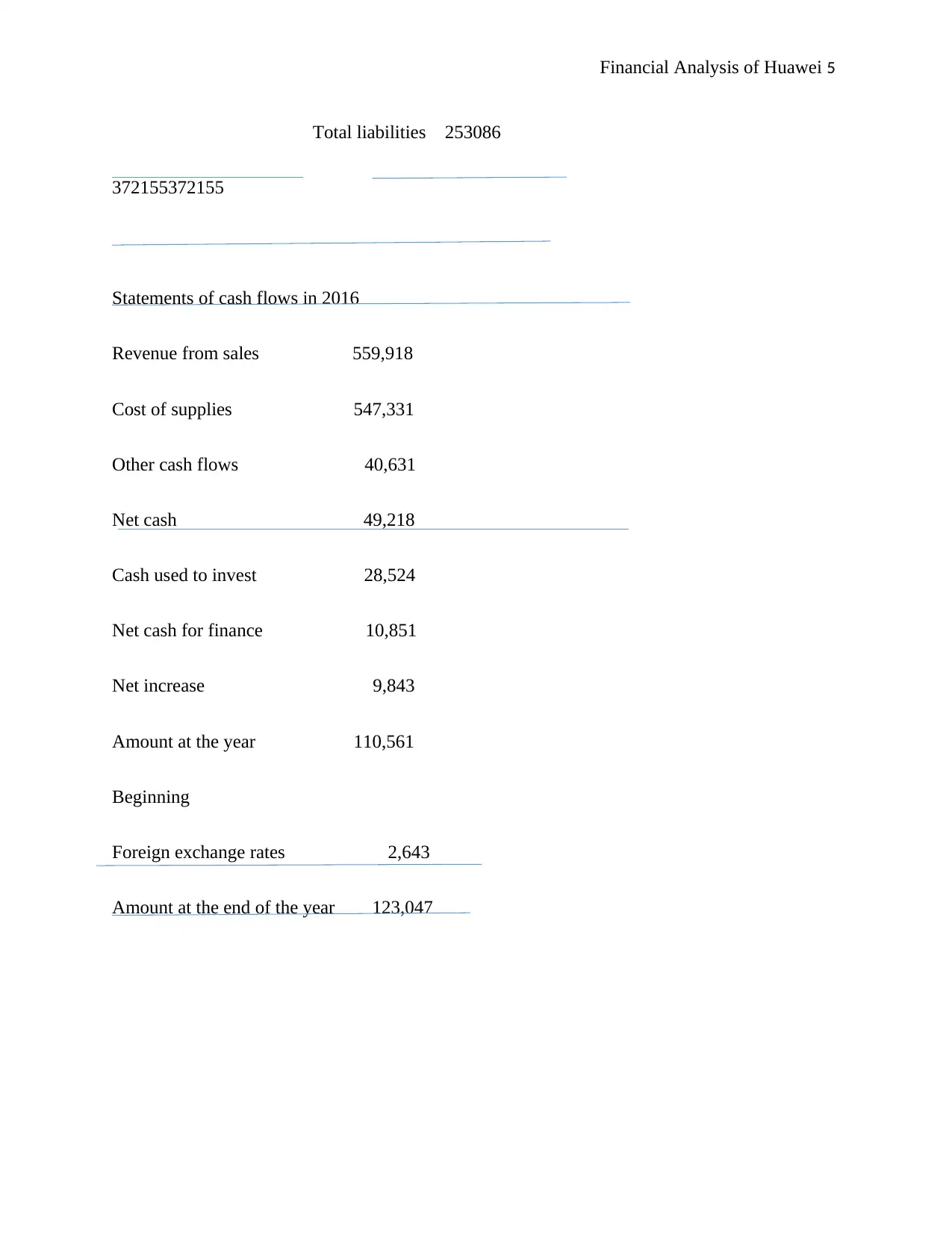
Financial Analysis of Huawei 5
Total liabilities 253086
372155372155
Statements of cash flows in 2016
Revenue from sales 559,918
Cost of supplies 547,331
Other cash flows 40,631
Net cash 49,218
Cash used to invest 28,524
Net cash for finance 10,851
Net increase 9,843
Amount at the year 110,561
Beginning
Foreign exchange rates 2,643
Amount at the end of the year 123,047
Total liabilities 253086
372155372155
Statements of cash flows in 2016
Revenue from sales 559,918
Cost of supplies 547,331
Other cash flows 40,631
Net cash 49,218
Cash used to invest 28,524
Net cash for finance 10,851
Net increase 9,843
Amount at the year 110,561
Beginning
Foreign exchange rates 2,643
Amount at the end of the year 123,047
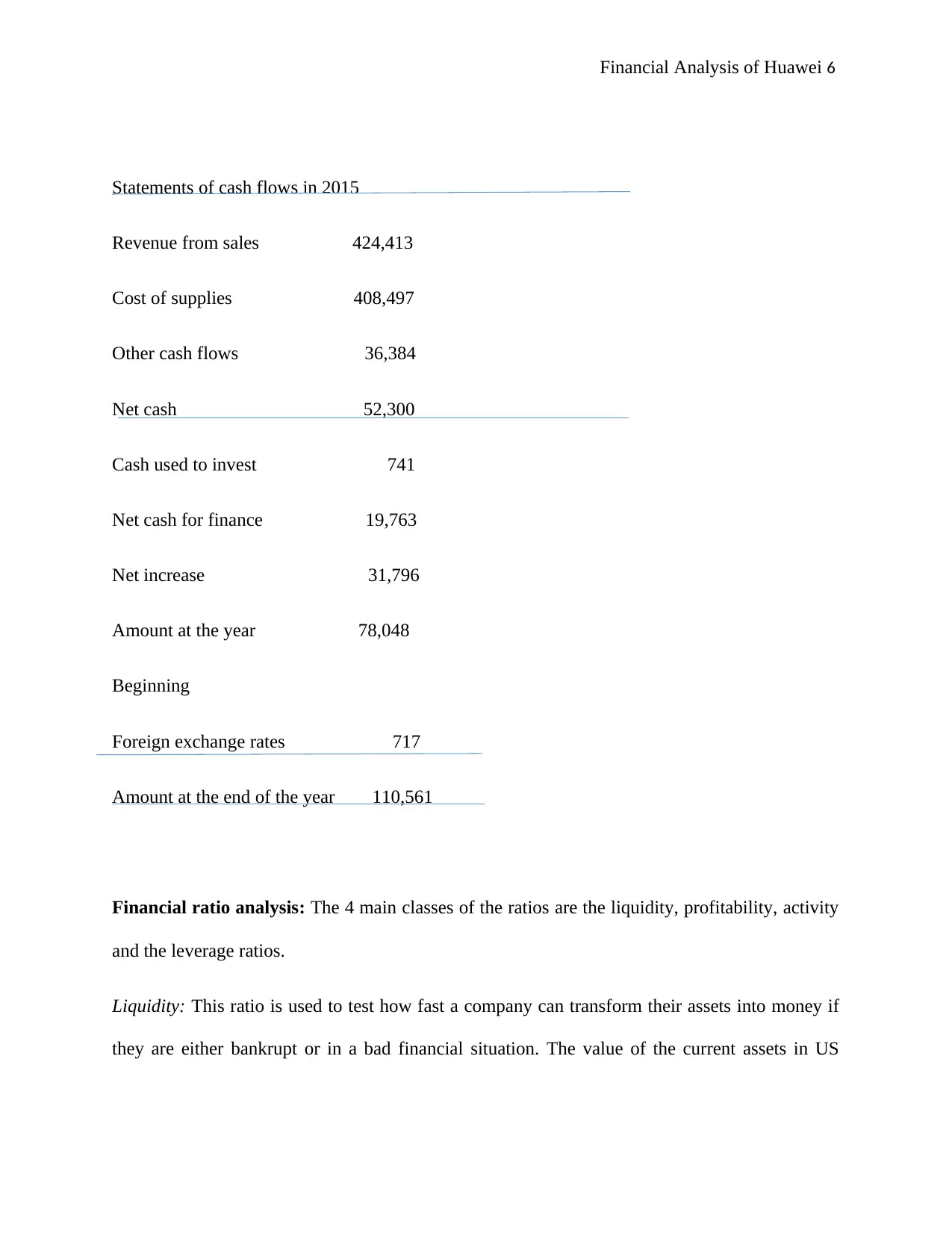
Financial Analysis of Huawei 6
Statements of cash flows in 2015
Revenue from sales 424,413
Cost of supplies 408,497
Other cash flows 36,384
Net cash 52,300
Cash used to invest 741
Net cash for finance 19,763
Net increase 31,796
Amount at the year 78,048
Beginning
Foreign exchange rates 717
Amount at the end of the year 110,561
Financial ratio analysis: The 4 main classes of the ratios are the liquidity, profitability, activity
and the leverage ratios.
Liquidity: This ratio is used to test how fast a company can transform their assets into money if
they are either bankrupt or in a bad financial situation. The value of the current assets in US
Statements of cash flows in 2015
Revenue from sales 424,413
Cost of supplies 408,497
Other cash flows 36,384
Net cash 52,300
Cash used to invest 741
Net cash for finance 19,763
Net increase 31,796
Amount at the year 78,048
Beginning
Foreign exchange rates 717
Amount at the end of the year 110,561
Financial ratio analysis: The 4 main classes of the ratios are the liquidity, profitability, activity
and the leverage ratios.
Liquidity: This ratio is used to test how fast a company can transform their assets into money if
they are either bankrupt or in a bad financial situation. The value of the current assets in US
⊘ This is a preview!⊘
Do you want full access?
Subscribe today to unlock all pages.

Trusted by 1+ million students worldwide

Financial Analysis of Huawei 7
million dollars in reference to the 2016 financial statements given by Huawei is 355,502, while
the value of the current liabilities is 239,271. Since the current ratio is given by:
C.R= C.A/C.L where C.R is the current ratio, C.A is the current assets and C.L is the current
liabilities, then
Current assets=355,502/239,271 =1.48577
Huawei is able to remain in operation since its liquidity ratio is high.
Profitability: This ratio shows how much gain or loss the company is making. The company’s
profit has been increasing for the past 5 years. The table below has a record of Huawei’s net
profit in a million US dollars against their respective years.
Year 2013 2014 2015 2016 2017
Net profit 21,003 27,866 36,910 37,052 47,455
Leverage: This ratio shows the extent of the reliability of a company in using their liabilities to
fund and run their operations. The liability to equity ratio of Huawei in 2016 is calculated as:
Ratio of leverage=total liabilities/total equity
=301,501/140,133 =2.18008
So the company relies so much on their debts to fund their day to day operations.
Activity: The common form of this ratios are the receivable and the payable account turnover.
Huawei pays off their workers' employees and suppliers on time. The cash flows statement of
million dollars in reference to the 2016 financial statements given by Huawei is 355,502, while
the value of the current liabilities is 239,271. Since the current ratio is given by:
C.R= C.A/C.L where C.R is the current ratio, C.A is the current assets and C.L is the current
liabilities, then
Current assets=355,502/239,271 =1.48577
Huawei is able to remain in operation since its liquidity ratio is high.
Profitability: This ratio shows how much gain or loss the company is making. The company’s
profit has been increasing for the past 5 years. The table below has a record of Huawei’s net
profit in a million US dollars against their respective years.
Year 2013 2014 2015 2016 2017
Net profit 21,003 27,866 36,910 37,052 47,455
Leverage: This ratio shows the extent of the reliability of a company in using their liabilities to
fund and run their operations. The liability to equity ratio of Huawei in 2016 is calculated as:
Ratio of leverage=total liabilities/total equity
=301,501/140,133 =2.18008
So the company relies so much on their debts to fund their day to day operations.
Activity: The common form of this ratios are the receivable and the payable account turnover.
Huawei pays off their workers' employees and suppliers on time. The cash flows statement of
Paraphrase This Document
Need a fresh take? Get an instant paraphrase of this document with our AI Paraphraser
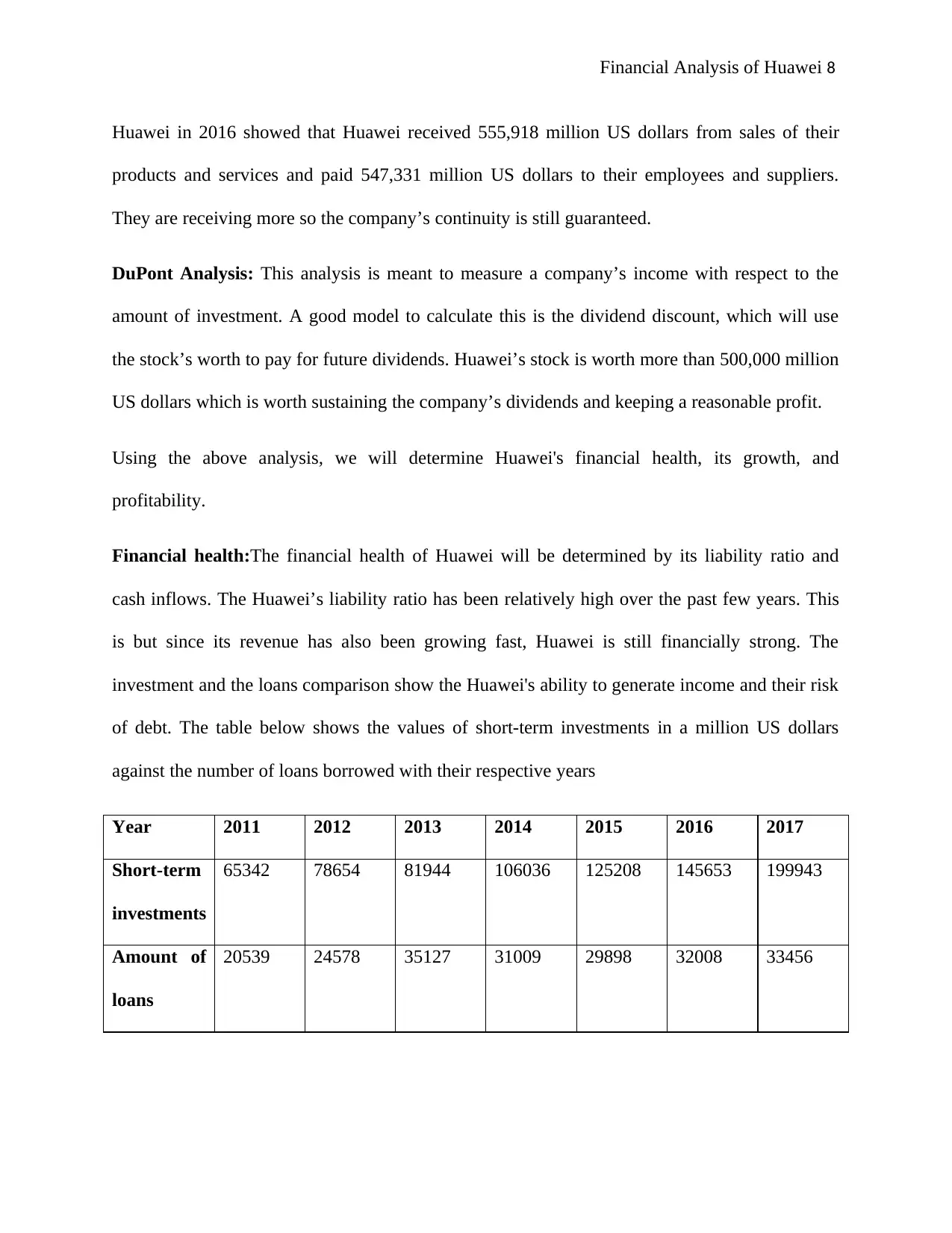
Financial Analysis of Huawei 8
Huawei in 2016 showed that Huawei received 555,918 million US dollars from sales of their
products and services and paid 547,331 million US dollars to their employees and suppliers.
They are receiving more so the company’s continuity is still guaranteed.
DuPont Analysis: This analysis is meant to measure a company’s income with respect to the
amount of investment. A good model to calculate this is the dividend discount, which will use
the stock’s worth to pay for future dividends. Huawei’s stock is worth more than 500,000 million
US dollars which is worth sustaining the company’s dividends and keeping a reasonable profit.
Using the above analysis, we will determine Huawei's financial health, its growth, and
profitability.
Financial health:The financial health of Huawei will be determined by its liability ratio and
cash inflows. The Huawei’s liability ratio has been relatively high over the past few years. This
is but since its revenue has also been growing fast, Huawei is still financially strong. The
investment and the loans comparison show the Huawei's ability to generate income and their risk
of debt. The table below shows the values of short-term investments in a million US dollars
against the number of loans borrowed with their respective years
Year 2011 2012 2013 2014 2015 2016 2017
Short-term
investments
65342 78654 81944 106036 125208 145653 199943
Amount of
loans
20539 24578 35127 31009 29898 32008 33456
Huawei in 2016 showed that Huawei received 555,918 million US dollars from sales of their
products and services and paid 547,331 million US dollars to their employees and suppliers.
They are receiving more so the company’s continuity is still guaranteed.
DuPont Analysis: This analysis is meant to measure a company’s income with respect to the
amount of investment. A good model to calculate this is the dividend discount, which will use
the stock’s worth to pay for future dividends. Huawei’s stock is worth more than 500,000 million
US dollars which is worth sustaining the company’s dividends and keeping a reasonable profit.
Using the above analysis, we will determine Huawei's financial health, its growth, and
profitability.
Financial health:The financial health of Huawei will be determined by its liability ratio and
cash inflows. The Huawei’s liability ratio has been relatively high over the past few years. This
is but since its revenue has also been growing fast, Huawei is still financially strong. The
investment and the loans comparison show the Huawei's ability to generate income and their risk
of debt. The table below shows the values of short-term investments in a million US dollars
against the number of loans borrowed with their respective years
Year 2011 2012 2013 2014 2015 2016 2017
Short-term
investments
65342 78654 81944 106036 125208 145653 199943
Amount of
loans
20539 24578 35127 31009 29898 32008 33456
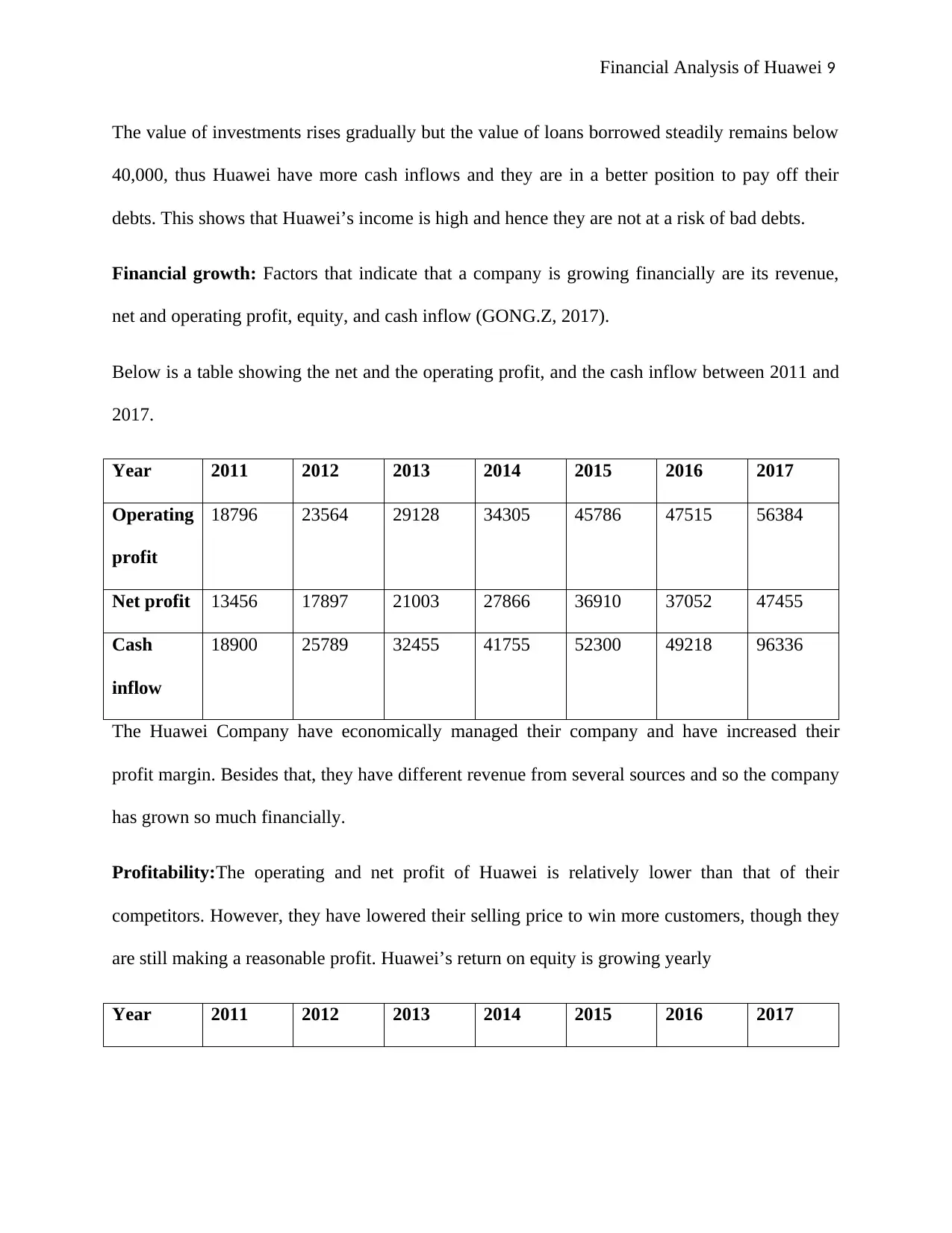
Financial Analysis of Huawei 9
The value of investments rises gradually but the value of loans borrowed steadily remains below
40,000, thus Huawei have more cash inflows and they are in a better position to pay off their
debts. This shows that Huawei’s income is high and hence they are not at a risk of bad debts.
Financial growth: Factors that indicate that a company is growing financially are its revenue,
net and operating profit, equity, and cash inflow (GONG.Z, 2017).
Below is a table showing the net and the operating profit, and the cash inflow between 2011 and
2017.
Year 2011 2012 2013 2014 2015 2016 2017
Operating
profit
18796 23564 29128 34305 45786 47515 56384
Net profit 13456 17897 21003 27866 36910 37052 47455
Cash
inflow
18900 25789 32455 41755 52300 49218 96336
The Huawei Company have economically managed their company and have increased their
profit margin. Besides that, they have different revenue from several sources and so the company
has grown so much financially.
Profitability:The operating and net profit of Huawei is relatively lower than that of their
competitors. However, they have lowered their selling price to win more customers, though they
are still making a reasonable profit. Huawei’s return on equity is growing yearly
Year 2011 2012 2013 2014 2015 2016 2017
The value of investments rises gradually but the value of loans borrowed steadily remains below
40,000, thus Huawei have more cash inflows and they are in a better position to pay off their
debts. This shows that Huawei’s income is high and hence they are not at a risk of bad debts.
Financial growth: Factors that indicate that a company is growing financially are its revenue,
net and operating profit, equity, and cash inflow (GONG.Z, 2017).
Below is a table showing the net and the operating profit, and the cash inflow between 2011 and
2017.
Year 2011 2012 2013 2014 2015 2016 2017
Operating
profit
18796 23564 29128 34305 45786 47515 56384
Net profit 13456 17897 21003 27866 36910 37052 47455
Cash
inflow
18900 25789 32455 41755 52300 49218 96336
The Huawei Company have economically managed their company and have increased their
profit margin. Besides that, they have different revenue from several sources and so the company
has grown so much financially.
Profitability:The operating and net profit of Huawei is relatively lower than that of their
competitors. However, they have lowered their selling price to win more customers, though they
are still making a reasonable profit. Huawei’s return on equity is growing yearly
Year 2011 2012 2013 2014 2015 2016 2017
⊘ This is a preview!⊘
Do you want full access?
Subscribe today to unlock all pages.

Trusted by 1+ million students worldwide
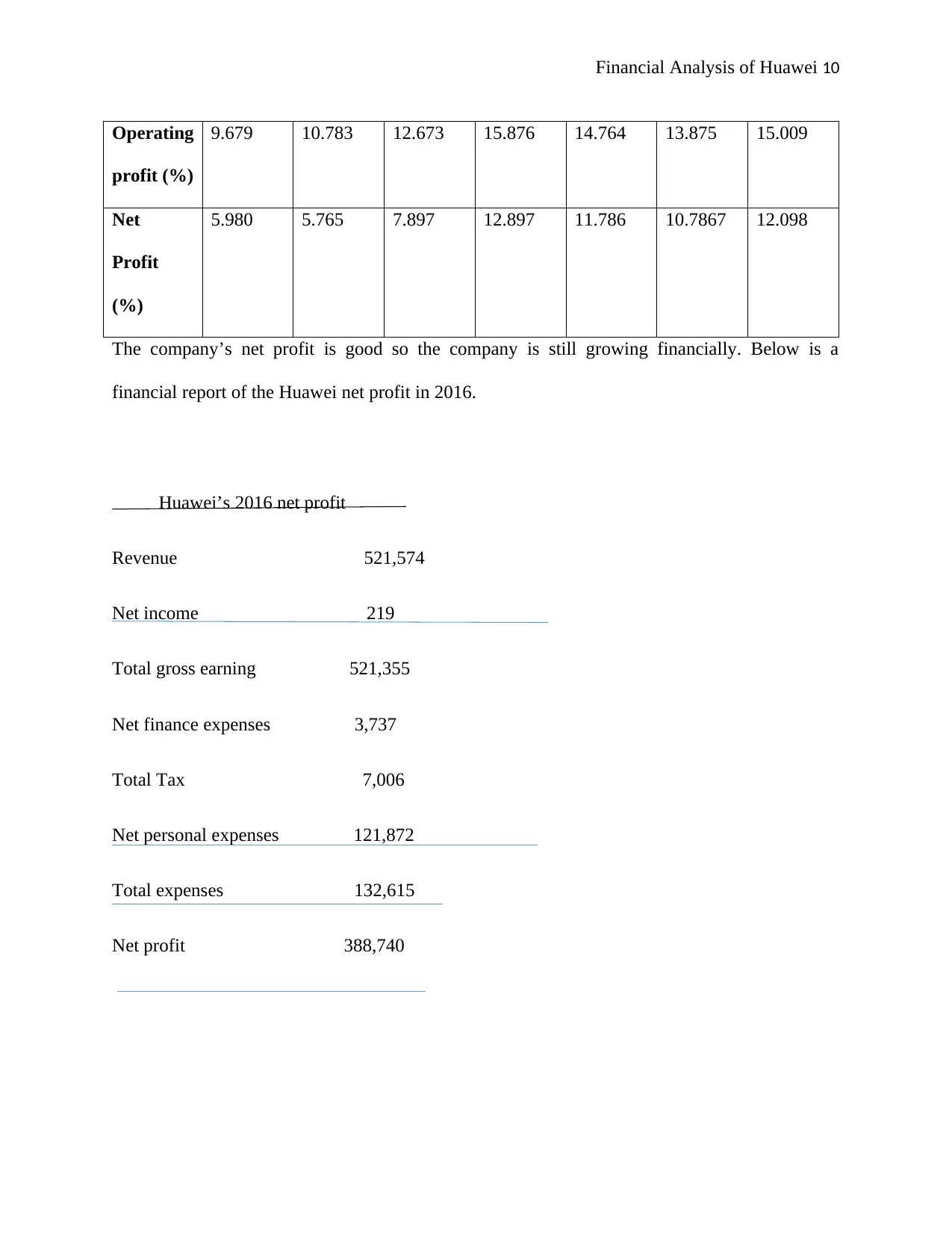
Financial Analysis of Huawei 10
Operating
profit (%)
9.679 10.783 12.673 15.876 14.764 13.875 15.009
Net
Profit
(%)
5.980 5.765 7.897 12.897 11.786 10.7867 12.098
The company’s net profit is good so the company is still growing financially. Below is a
financial report of the Huawei net profit in 2016.
Huawei’s 2016 net profit
Revenue 521,574
Net income 219
Total gross earning 521,355
Net finance expenses 3,737
Total Tax 7,006
Net personal expenses 121,872
Total expenses 132,615
Net profit 388,740
Operating
profit (%)
9.679 10.783 12.673 15.876 14.764 13.875 15.009
Net
Profit
(%)
5.980 5.765 7.897 12.897 11.786 10.7867 12.098
The company’s net profit is good so the company is still growing financially. Below is a
financial report of the Huawei net profit in 2016.
Huawei’s 2016 net profit
Revenue 521,574
Net income 219
Total gross earning 521,355
Net finance expenses 3,737
Total Tax 7,006
Net personal expenses 121,872
Total expenses 132,615
Net profit 388,740
Paraphrase This Document
Need a fresh take? Get an instant paraphrase of this document with our AI Paraphraser
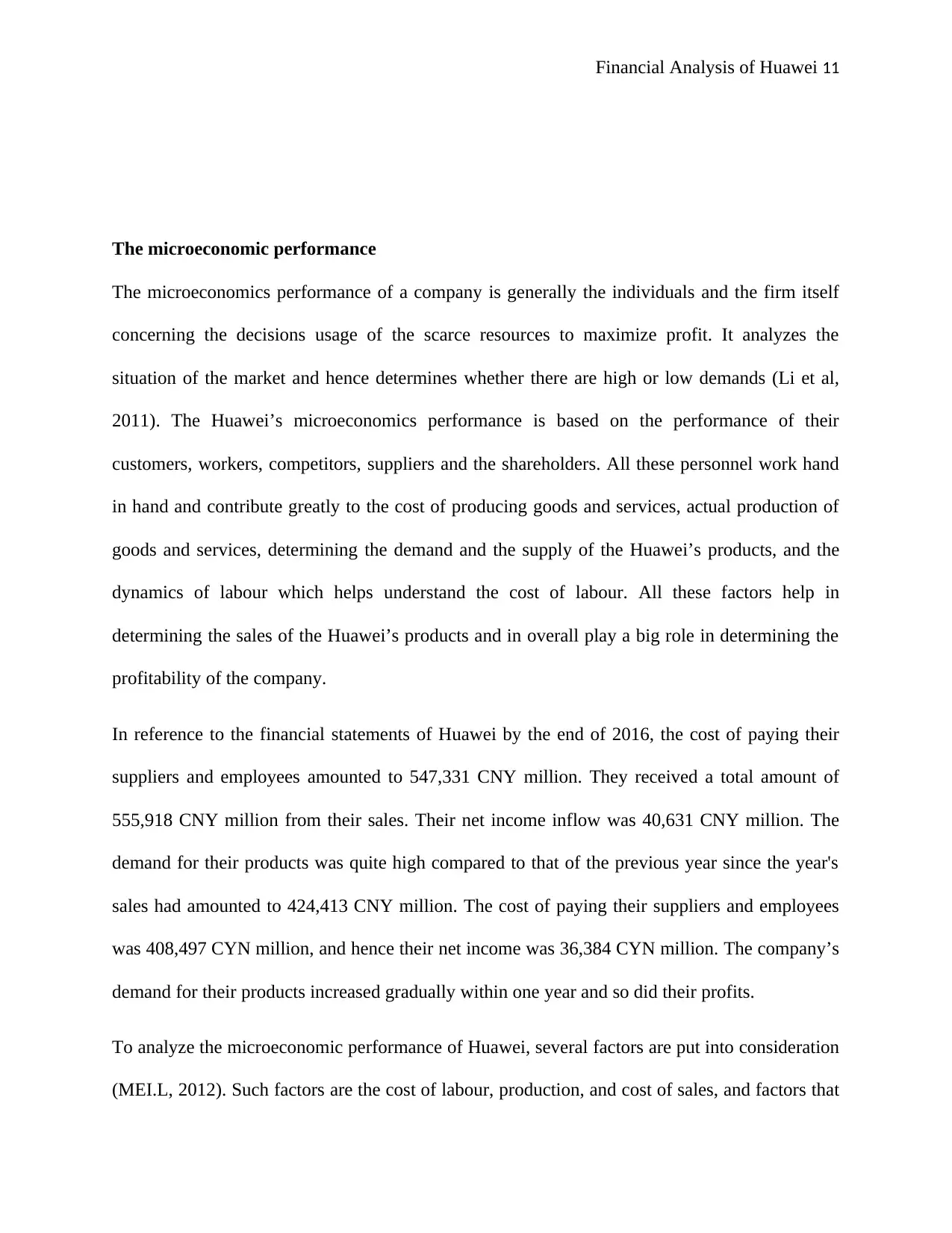
Financial Analysis of Huawei 11
The microeconomic performance
The microeconomics performance of a company is generally the individuals and the firm itself
concerning the decisions usage of the scarce resources to maximize profit. It analyzes the
situation of the market and hence determines whether there are high or low demands (Li et al,
2011). The Huawei’s microeconomics performance is based on the performance of their
customers, workers, competitors, suppliers and the shareholders. All these personnel work hand
in hand and contribute greatly to the cost of producing goods and services, actual production of
goods and services, determining the demand and the supply of the Huawei’s products, and the
dynamics of labour which helps understand the cost of labour. All these factors help in
determining the sales of the Huawei’s products and in overall play a big role in determining the
profitability of the company.
In reference to the financial statements of Huawei by the end of 2016, the cost of paying their
suppliers and employees amounted to 547,331 CNY million. They received a total amount of
555,918 CNY million from their sales. Their net income inflow was 40,631 CNY million. The
demand for their products was quite high compared to that of the previous year since the year's
sales had amounted to 424,413 CNY million. The cost of paying their suppliers and employees
was 408,497 CYN million, and hence their net income was 36,384 CYN million. The company’s
demand for their products increased gradually within one year and so did their profits.
To analyze the microeconomic performance of Huawei, several factors are put into consideration
(MEI.L, 2012). Such factors are the cost of labour, production, and cost of sales, and factors that
The microeconomic performance
The microeconomics performance of a company is generally the individuals and the firm itself
concerning the decisions usage of the scarce resources to maximize profit. It analyzes the
situation of the market and hence determines whether there are high or low demands (Li et al,
2011). The Huawei’s microeconomics performance is based on the performance of their
customers, workers, competitors, suppliers and the shareholders. All these personnel work hand
in hand and contribute greatly to the cost of producing goods and services, actual production of
goods and services, determining the demand and the supply of the Huawei’s products, and the
dynamics of labour which helps understand the cost of labour. All these factors help in
determining the sales of the Huawei’s products and in overall play a big role in determining the
profitability of the company.
In reference to the financial statements of Huawei by the end of 2016, the cost of paying their
suppliers and employees amounted to 547,331 CNY million. They received a total amount of
555,918 CNY million from their sales. Their net income inflow was 40,631 CNY million. The
demand for their products was quite high compared to that of the previous year since the year's
sales had amounted to 424,413 CNY million. The cost of paying their suppliers and employees
was 408,497 CYN million, and hence their net income was 36,384 CYN million. The company’s
demand for their products increased gradually within one year and so did their profits.
To analyze the microeconomic performance of Huawei, several factors are put into consideration
(MEI.L, 2012). Such factors are the cost of labour, production, and cost of sales, and factors that

Financial Analysis of Huawei 12
control the demand and supply of goods and services. TheApple and Samsung companies are the
Huawei’s greatest competitors. They have a higher profit margin than the Huawei Company.
They have a better advantage of labour so the cost of their labour its lower. They make more
sales per year than Huawei. Samsung is the greatest mobile producer followed by Apple. Huawei
is struggling hard to keep their clients and maintain a good profit margin. Apple made a revenue
of $229 billion, Samsung made a revenue of $312.892 billion while Huawei made a revenue of
$92.549 billion. Huawei is still a way behind its competitors and they are struggling hard to keep
up with their pace. Huawei’s profit margin is increasing gradually every year and so they will be
way ahead of their competitors
Being a global company, Huawei has a greater advantage when they need loans and leases to
fund their operations. One of the global finance companies that funds the Huawei Company is
the PO which helps the Huawei’s partners to access Huawei’s products and services in a cost-
effective way. Besides, because of their large economies of scale, financial institutions are
always more than willing to lend them money. As a result, the company can still invest more on
its production and produce more of their services effectively.
Conclusion
In view of the financial situation of the Huawei Company, it is clear that this global company
will grow more and produce one of the world’s best telecommunication devices. From the
company’s annual reports, it is clear that the company is a profit making company and in the due
time, it will be among the largest firms operating globally. We are looking forward to seeing
them come up with their own operating system.
control the demand and supply of goods and services. TheApple and Samsung companies are the
Huawei’s greatest competitors. They have a higher profit margin than the Huawei Company.
They have a better advantage of labour so the cost of their labour its lower. They make more
sales per year than Huawei. Samsung is the greatest mobile producer followed by Apple. Huawei
is struggling hard to keep their clients and maintain a good profit margin. Apple made a revenue
of $229 billion, Samsung made a revenue of $312.892 billion while Huawei made a revenue of
$92.549 billion. Huawei is still a way behind its competitors and they are struggling hard to keep
up with their pace. Huawei’s profit margin is increasing gradually every year and so they will be
way ahead of their competitors
Being a global company, Huawei has a greater advantage when they need loans and leases to
fund their operations. One of the global finance companies that funds the Huawei Company is
the PO which helps the Huawei’s partners to access Huawei’s products and services in a cost-
effective way. Besides, because of their large economies of scale, financial institutions are
always more than willing to lend them money. As a result, the company can still invest more on
its production and produce more of their services effectively.
Conclusion
In view of the financial situation of the Huawei Company, it is clear that this global company
will grow more and produce one of the world’s best telecommunication devices. From the
company’s annual reports, it is clear that the company is a profit making company and in the due
time, it will be among the largest firms operating globally. We are looking forward to seeing
them come up with their own operating system.
⊘ This is a preview!⊘
Do you want full access?
Subscribe today to unlock all pages.

Trusted by 1+ million students worldwide
1 out of 18
Related Documents
Your All-in-One AI-Powered Toolkit for Academic Success.
+13062052269
info@desklib.com
Available 24*7 on WhatsApp / Email
![[object Object]](/_next/static/media/star-bottom.7253800d.svg)
Unlock your academic potential
Copyright © 2020–2025 A2Z Services. All Rights Reserved. Developed and managed by ZUCOL.





